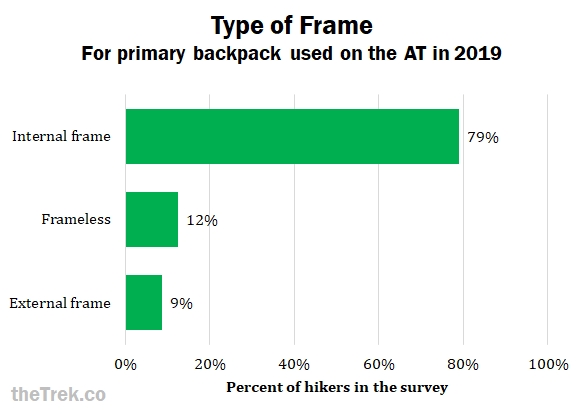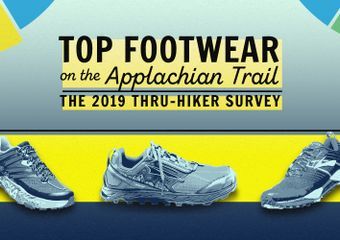Top Backpacks: The 2019 Appalachian Trail Thru-Hiker Survey
In this installment of The Trek’s 2019 Hiker Survey, we cover backpacks and base weight. We asked hikers about the frame type, capacity, brand, and model of their backpacks. This year a different brand and model emerged as the top choice ultralight pack. In the past, we’ve found that the load within that pack affects hikers’ perceptions of the backpack itself, so we’ve also looked into the weight hikers carry. Hikers this year packed a little differently from how they did in previous years. For the charts and details, keep reading, or else skip to the TL;DR at the bottom.
The Hikers
365 hikers participated in the survey, all of whom had walked a section or thru-hike of the AT in 2019. Almost three-quarters were thru-hikers and the rest were section hikers. For more details on the hiker demographics, check out our post with general information from the survey.
Most hikers had done backpacking trips just a few days long prior to their thru-hikes. Extensive experience and complete lack of experience were both uncommon.
Frame Type
Most hikers used internal frame packs. Frameless packs, which are typically used for ultralight backpacking, were less common. External frame packs have started making a comeback. A few hikers with external frame packs may have used old, heavy duty external frame models, but most external frame backpacks used were newer ultralight packs.
Capacity
Thru-hikers packs had an average (mean) capacity of 52 liters, but anything between about 43 and 61 liters was common. Thru-hiker pack capacities ranged from 25 to 80 liters.
The average capacity of section hikers’ packs was 48 liters, and anything from 40 to 60 liters was common. Their packs ranged in capacity from 6.5 liters to 70 liters. (The one section hiker who used a 6.5-liter day pack wasn’t included on the graph.)
There was not a significant difference in pack capacity for thru-hikers compared to section hikers.1
Top Brands and Models
We asked hikers which brand and model of pack they used on the AT was their favorite.
Overall Top Packs
Most popular standard pack
Osprey Exos (39 hikers)

Most popular ultralight pack
Zpacks Arc Haul (23 hikers)

Most popular women’s pack
Osprey Aura (20 hikers)

The Osprey Exos continues to be the most popular pack overall, and the Osprey Aura continues to be the most popular women’s pack. For ultralight packs, The Zpacks Arc Haul overtook the ULA Circuit, which had been the most popular ultralight pack in 2018.
Top Ranked Brands and Models
-
Osprey (137 hikers)
-
Zpacks (42)
-
Hyperlite Mountain Gear(36)
- Southwest series (17)
- Windrider series (16)
-
Gossamer Gear (32)
-
ULA (24)
- Circuit (19)
-
Granite Gear (19)
- Crown 2 (10)
-
Gregory (17)
- Maven (3)
-
Deuter (8)
- Air Contact (2)
-
Mountain Laurel Designs (6)
- Prophet (5)
-
Superior Wilderness Designs (6)
- Long Haul (4)
Base Weight
Base weight refers to how much a backpack weighs when it is filled with everything except food and water. This often fluctuates during a long-distance hike, but it is more stable than total pack weight with food and water. Hikers in our survey reported the typical base weight during their 2019 AT hike.
Thru-hikers’ average base weight was 19 pounds. Base weights ranged from 7 pounds to 44 pounds. As shown by the black bracket, base weights between 14 and 20 pounds were all pretty common. The average base weight for section hikers was 19 pounds, with a range from 6 to 35 pounds.
In 2019, the average base weight was not significantly different for section hikers compared to thru-hikers (base weights had been different from 2016 to 2018). This is because section hikers lowered their base weight in 2019 (average 19 pounds) compared to their average base weight the previous years (22 pounds in 2018). Our data continues to suggest that anyone planning to thru-hike should attempt to get their base weight as low as possible, but at least 20 pounds or less.2
No Problems with Weight and Capacity
Hikers who had smaller-capacity packs carried significantly lower base weights.3 This is a good thing, and it’s different from previous years, when even hikers with small packs were carrying loads of the same weight.
In order to get a better understanding of the role weight and pack size play in pack satisfaction, I looked at base weight and pack capacity as a predictor of pack satisfaction, controlling for frame type, prior experience, and distance hiked. None of these predicted pack satisfaction this year.4 In the past few years, many hikers had a mismatch between their base weight and pack capacity, which seemed to be the reason they were dissatisfied with their packs. This year, when hikers were carrying a more appropriate weight for their pack size, neither base weight nor pack capacity appeared to impact pack satisfaction.
I continue to recommend that you should not use ultralight packs aspirationally. If you can’t maintain an ultralight load, you may be more uncomfortable from cramming too much into a less-supportive, smaller space. For beginner hikers who aren’t sure what base weight they can commit to, I would recommend getting a standard pack with a removable brain (basically a smaller bag at the top that can be removed). That way, if you are able to lighten your load, you can downsize your pack at that time. Each of the most popular standard pack models ranked above, the Osprey Exos and Aura, has a brain.
TL;DR
- Most thru- and section hikers use internal frame packs, but ultralight frameless and external frame packs are not uncommon.
- If you intend to thru-hike, aim for a base weight of 20 pounds or less. Many hikers manage a base weight of 15 pounds. Aim for that if you can.
- This year, hikers did a better job of packing lightly if they were using lower-capacity packs.
- Use a framed pack if your base weight is 20 pounds or more. There’s no need to splurge on state-of-the-art ultralight gear if you aren’t actually hiking ultralight.
- So, if you aspire to be ultralight but don’t have much experience, get a pack with a brain and downsize when you can.
- For example, the most popular standard pack, the Osprey Exos, has a brain, as does the most popular women’s pack, the Osprey Aura.
- This year, ZPacks pulled ahead of the ULA Circuit to be ranked the most popular ultralight pack.
Thank You!
Hi hikers! Apologies for taking so long to get this post out. I know many 2020 thru-hikers have already started, so I feel bad that I didn’t get this information out soon enough to be helpful to the early starters (yesterday was my trailversary so you guys are on my mind!). This has been a busy winter for me and I struggled to keep up with everything.
Many thanks to all the hikers who participated in the survey! Congratulations for walking so far! I am grateful to Maggie Slepian and Zach Davis for their input and for distributing the survey. Thank you to everyone reading this for your patience with my delays in getting it out.
Want to Contribute to Next Year’s Surveys?
I will need some help next year to get all the survey posts done more quickly. If you are interested in helping with these posts next year, please contact The Trek. It would be especially helpful if you are familiar with R/R Studio statistical software and/or making graphs in Excel, and if you have done long-distance backpacking. Contact The Trek here if you would like to help.
More from the Annual Hiker Survey
Check out the 2019 overview post, as well as the posts on footwear, sleeping bags, and shelter systems. I have one more post to get out this season, on stoves and food. If you’d like to be updated on subsequent posts, subscribe to The Trek newsletter.
Notes for the nerds
For a two-sided independent samples t-test with a 95 percent confidence interval, t = 0.690, df = 98, p = 0.492.
Pearson’s r = -.07, p = .205, for the variables Distance Hiked and Average Base Weight.
Pearson’s r = .29, p < .0001, for the variables Pack Capacity and Average Base Weight.
Multivariate linear regression was conducted with pack satisfaction as the outcome and base weight, distance hiked, pack capacity, frame type, and prior experience as predictors.There were no significant predictors at a 95% confidence interval. The overall model statistics were R2 = .034, F(5, 342) = 2.379, p = 0.038.
This website contains affiliate links, which means The Trek may receive a percentage of any product or service you purchase using the links in the articles or advertisements. The buyer pays the same price as they would otherwise, and your purchase helps to support The Trek's ongoing goal to serve you quality backpacking advice and information. Thanks for your support!
To learn more, please visit the About This Site page.







Comments 7
Very informative and helpful.
Thanks for sharing!
Will the satisfaction data get shared next?
It is interesting to see what people used but the teaser about satisfaction got my interest.
Thanks!
It seems a bit odd that you say packs ranging from 43-61 L or 40-60 L were common, when 65L packs were more common for either section or through hikers than 50L or any size smaller…. The data I’m seeing shows 50-65L being the most common for both, although if you wanted to extend the range and say 40-65 I wouldn’t quibble.
The range I referred to was +/- 1 standard deviation for thru-hiker pack capacity and section hiker capacity. For both section and thru-hikers, you can see that the capacity data are left-skewed, so +/- 1 SD does not entirely correspond to the mode or median pack capacity, which you correctly noticed was a bit higher. A main reason I show the graphs and give these ranges is because it’s a little complicated to describe the “typical” pack and to give meaningful advice about what pack to use unless I provide more than one of these numbers (mean, median, mode, and sd).
Could you add a list of the packs that you have counted as “other brands” or “other” in earlier articles, so that readers may see a complete list of the packs used?